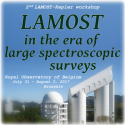Speaker
Jeff Carlin
(LSST)
Description
Although the majority of stars observed by LAMOST are brighter than 17th magnitude, the spectroscopic stellar parameters can be used to select more than 10,000 red giant stars in the Milky Way halo from among the more numerous foreground dwarfs. In this talk, I will discuss some efforts to use LAMOST-selected distant RGB stars to probe the merging history of the Galaxy via tidal debris in the halo. I will detail results from our method to statistically detect stellar excess structures (which we call ``SHARDS,'' or Stellar Halo Accretion-Related Debris Structures). This technique uses correlations in velocity-distance phase space, accounting for the LAMOST selection function, to statistically identify stellar excesses relative to a smooth underlying model of Galactic populations. We find that at least 10% of the Milky Way halo stars from LAMOST are part of SHARDS, and that the LAMOST data contain excess substructure over all Galactocentric radii less than 40 kpc, beyond what is expected due to statistical fluctuations and incomplete sampling of a smooth halo. The level of substructure is consistent with the fraction of stars in SHARDS from model halos created entirely from accreted satellites. I will also discuss insights into the nature of the Sagittarius tidal stream gleaned from late-type giants observed by LAMOST, as well as perturbations in the Galactic disk that may be signatures of the effects of dwarf galaxies merging with the Milky Way. Finally, I will speculate about future avenues toward characterizing known tidal substructures via their LAMOST detections, and extending the statistical characterization of SHARDS in the Galactic stellar halo to include velocities and stellar metallicities (and possibly alpha abundances) as additional signatures of the merging history of our Galaxy.
Primary author
Jeff Carlin
(LSST)

